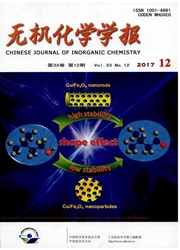

 中文摘要:
中文摘要:
通过在介孔结构金属有机框架材料MIL-101(Cr)和MIL-100(Al)的孔洞中合成自旋交叉化合物[Fe(HB(pz)3)2]的方法,可以得到SCO@MOF复合物。通过红外光谱(FTIR)、粉末X射线衍射(PXRD)、原子吸收光谱(AAS)以及气体吸附-脱附等进行了进一步测试。通过变温磁测量对复合材料的温度诱导自旋转换行为的研究表明,复合材料的自旋转换行为发生改变甚至是消失了。复合材料的这一现象可以解释为[Fe(HB(pz)3)2]在MOF主体材料的孔洞中形成了一种新的结晶相,且孔壁压力将会阻碍[Fe(HB(pz)3)2]从低自旋态向高自旋态转变。不同SCO@MOF复合物得到了相似的自旋转换行为结果。这确认了当自旋交叉化合物在金属有机框架材料孔洞中形成时,MOFs材料的限制压力或基体效应对其自旋转换行为的影响显然是至关重要的。
 英文摘要:
英文摘要:
The spin-crossover (SCO) compound[Fe(HB(pz)3)2] was synthesized in the pores of mesostructured metal-organic frameworks MIL-101(Cr) and MIL-100(Al) to yield SCO@MOF composites as evidenced by infrared spectrometry (FTIR), powder X-ray diffractometry (PXRD), atomic absorption (AAS) and gas adsorption-desorption studies. Studies of the temperature-induced spin crossover behavior of the composites by temperature-variable magnetic measurements of the composites indicate that the spin transitions of the composites are changed (TZ-SP-1) or disappeared (TZ-SP-2). The effect for SCO@MOF composites may be explained with formation of new crystalline phase of[Fe(HB(pz)3)2] in the pores of MOF host materials and the pore wall pressure of MOFs prevent the transition of[Fe(HB(pz)3)2] from low-spin state to high-spin state. The similar SCO behaviour of[Fe(HB(pz)3)2] for different SCO@MOF composites confirms that the confinement pressure or matrix effect on the spin transition is apparently crucial when the SCO compound is formed in the pores of metal-organic frameworks.
 同期刊论文项目
同期刊论文项目
 同项目期刊论文
同项目期刊论文
 期刊信息
期刊信息
